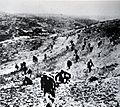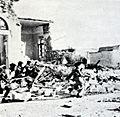1948 Palestine War facts for kids
Quick facts for kids 1948 Palestine War |
|||||||
|---|---|---|---|---|---|---|---|
| Part of Arab-Israeli Conflict | |||||||
 Raising the Ink Flag at Umm Rashrash (Eilat) |
|||||||
|
|||||||
| Belligerents | |||||||
| Israel |
Palestine |
||||||
| Commanders and leaders | |||||||
| David Ben-Gurion | Hajj Amin al-Husayni | ||||||
| Strength | |||||||
| 35,000 in May 1948, 96,441 by the end of the war | |||||||
The 1948 Palestine War was a major conflict in the Middle East. It is also called the War of Independence by Israelis. This war involved the new state of Israel, local Arabs, and nearby Arab countries.
The fighting started in 1947. This was after the British decided to end their control over Palestine. The land was supposed to be split into two countries. By 1949, Israel had gained more land than first planned. The Arab state that was supposed to be created never formed. Instead, the Gaza Strip went to Egypt, and the West Bank went to Jordan.
This war is still a big topic in the Middle East today. For Israelis, it marks the birth of their country. For Palestinians, it is known as The Nakba, meaning Catastrophe. They remember it as a time when their growing nation was broken up and many people were forced to leave their homes.
Contents
Why the War Started: Background
Jewish People Move to Palestine
Starting in 1881, many Jewish people from Europe began moving to Palestine. They were part of a movement called Zionism. This movement aimed to create a Jewish state. At first, Arabs and Jews got along. But as more Jews moved in, relations became difficult.
Palestinian Nationalism and the Great Revolt
During World War I, both Arabs and Jews lived under the Ottoman Empire. To weaken the Ottomans, Britain and France offered land to different groups. They offered Palestine to Arab leaders. At the same time, the British also offered control of Palestine to a future Jewish state. This made more Jews move to Palestine. It also made Palestinians fear losing control of their land.
In 1936, Palestinian Arabs started a revolt against the British and Jews. This Arab Revolt showed a strong sense of Palestinian identity. The British and Jews eventually stopped the revolt. However, it led to the White Paper of 1939. This paper limited Jewish immigrants to Palestine. It also aimed to give control of Israel to Palestine. This struggle for Palestine continued through World War II. After the war, the British control was ending. People in the region needed a solution.
The United Nations Plan for Palestine
In 1947, the British asked the United Nations (UN) to help. The UN decided to divide Palestine into two states. One would be Jewish, and one would be Arab. Both states would be about the same size. Jerusalem would be a special city run by the UN. The British would leave Palestine by May 1948.
Most countries, including the US and USSR, supported this plan. Jewish leaders in Palestine also agreed. However, Palestinian Arabs and several Arab nations disagreed. These nations included Egypt, Lebanon, Syria, Iraq, Saudi Arabia, and Jordan. They wanted a single Arab state with a Jewish minority. When their ideas were not accepted, these nations prepared for war. They raised armies to fight the new state of Israel.
Who Fought: Armed Forces
Israel's Army (Jewish Community)
Even though Israel was a new state, its army was very organized. This army was called the Haganah. It later became the modern Israeli Defense Force (IDF). By May 1948, Israel had an army of 35,000 soldiers. This number grew to 96,441 by the end of the war.
Israel had a clear plan and strong leaders. David Ben-Gurion, the defense minister, led the army. This unified leadership helped Israel in the war.
Palestinian Fighters
Unlike Israel, Palestinians did not have one single army. There were several small fighting groups. Hajj Amin al-Husayni tried to unite them. But many fighters did not like his leadership. He did create a group called the Holy War Army. This army was made up of volunteers and other fighters. However, they lacked modern weapons and supplies. Al-Husayni asked the Arab League for more help. But the League did not give him full control.
Arab League Armies
The Arab League nations that fought Israel were Egypt, Jordan, Iraq, Lebanon, and Syria. Saudi Arabia and Yemen also sent smaller forces. At the start of the war, there was no single commander for all these armies. Each country fought for its own goals. So, it was a collection of different armies, not one united force. The Arab Liberation Army was a group of 4,000 volunteers. They came from across the Middle East and operated from Syria.
What They Wanted: Objectives
Israel's Goals
Israel's main goal was to protect the land given to it by the UN. Their plan was to quickly build up their army. This was to fight against the Arab states they expected to invade. As the war continued, their goals changed. A new plan, Plan Dalet, was introduced in March 1948.
This plan aimed to remove Arabs from Jewish-controlled land. It also sought to defend Jewish settlements in Arab areas. Israel also wanted to take Arab land in certain places for a better defense. Historians like David Tal suggest this change was a response to strong Palestinian resistance. It was also to put Israeli forces in the best defensive spots. However, this part of the plan, which involved moving Palestinians, has caused much debate.
Palestine's Goals
Palestinians, led by the Arab Higher Committee, wanted to create one single Arab state in Palestine.
Jordan's Goals
Jordan seemed to agree with the Arab League about an Arab state in Palestine. However, King Abdullah of Jordan had another goal. He wanted to take control of Palestinian Arabs. He also hoped to take over Syria to create a "Greater Syria." This meant Jordan's goals were different from Syria, Lebanon, Egypt, and even the Palestinians.
Syria and Egypt's Goals
Syria and Egypt also supported a single Arab state in Palestine. But they mainly wanted to stop Jordan from becoming too powerful. They feared Jordan's expansion in the region.
How the War Happened: Course of the War
Phase 1: The Civil War (November 1947 - May 1948)
The first part of the war was between Israel's forces and Palestinian groups. It started on November 30, 1947, with three days of strikes. Then, it turned into small attacks against Jewish supply trucks. In January 1948, the Arab Liberation Army joined the fight. This strong resistance made Israel change its plans.
On April 5, Israel launched Operation Nahshon. This operation aimed to secure roads to Jerusalem. They took control of hills along the main roads. After this success, Palestinian resistance began to weaken.
Phase 2: Arab Countries Invade (May - June 1948)
The second part of the war began in May 1948. Egypt, Iraq, Jordan, Lebanon, and Syria invaded Palestine. Each army entered from its nearest border. Much of the fighting happened in the West Bank and around Jerusalem. Israeli forces moved into Jerusalem to secure the western part of the city. They also tried to take Latrun, a hill near Jerusalem, but failed.
In other areas, Israel had more success. Two Egyptian armies were stopped. The Iraqi army was pushed back. Syrian and Lebanese forces advanced into Israel. But Israelis also pushed back into Syrian and Lebanese territory. The fighting stopped on June 11 with a UN truce.
Phase 3: Israel vs. Jordan (July 1948)
On July 9, Israel launched new attacks against Jordan in the West Bank. They hoped to end the fighting against Jordan's Arab Legion. This was considered the best-trained Arab army. These attacks were mostly successful. Other Arab nations tried to take advantage, but their advances were small. This phase ended with another truce on July 18, 1948.
Phase 4: Israel vs. Egypt, Syria, and Lebanon (October 1948 - January 1949)
With Jordan stuck in the West Bank, Israel launched two more attacks on October 15. These attacks pushed Egyptian forces out of the Negev Desert. They also pushed Syrian and Lebanese forces back into their own countries. After these last attacks, the military part of the war ended. However, it took until January 7, 1949, for Israel to sign peace agreements with each warring nation.
What Happened After: Results
After the war, Israel gained a lot of land. The original UN plan gave equal land to Jewish and Arab states. But the 1949 agreements gave Israel a much larger state. Arab-controlled land was limited to the small Gaza Strip and a smaller West Bank. No Palestinian government controlled these areas. Egypt controlled the Gaza Strip, and Jordan controlled the West Bank and Eastern Jerusalem.
Another big result of the war was the Palestinian refugee crisis. By the end of the war, about 720,000 refugees lived in camps. These camps were in Syria, Jordan, Lebanon, the West Bank, and the Gaza Strip. Many people left due to wartime fear. Some historians say that Israeli policies, like Plan Dalet, also contributed. This plan encouraged Israeli forces to take Arab property in Jewish territory. This made the refugee problem worse. As of 2015, it is still unclear if these refugees can return home or receive payment for their losses.
Pictures from the War















